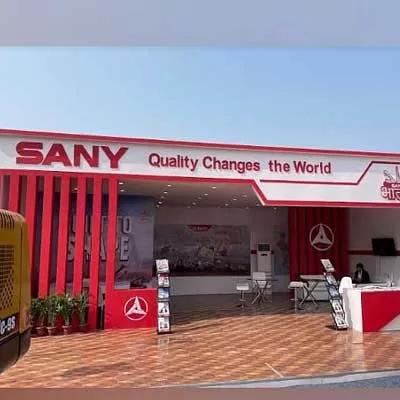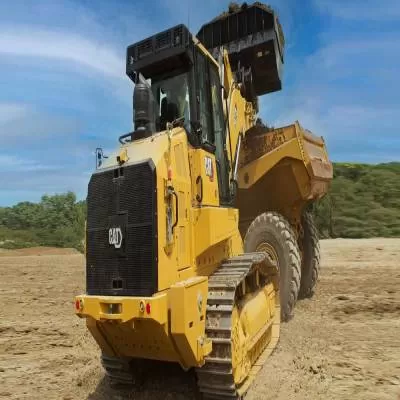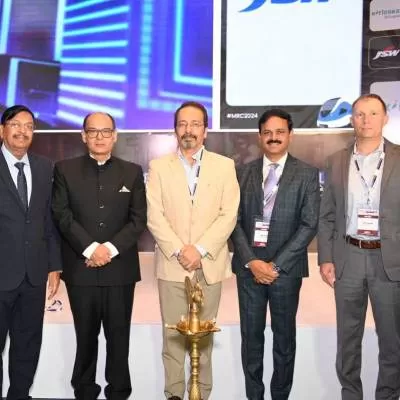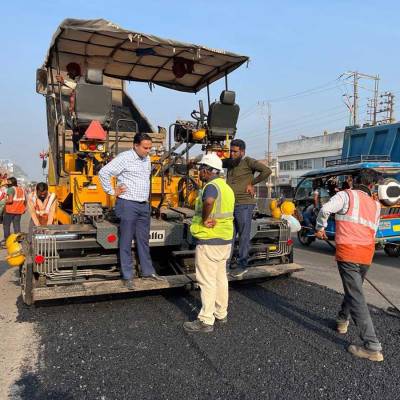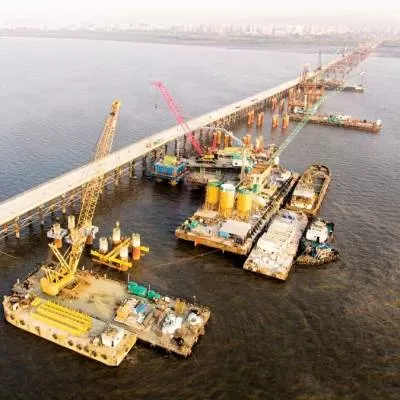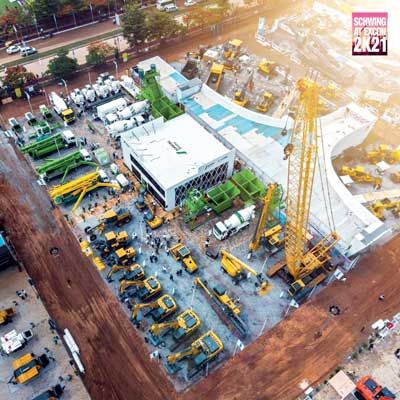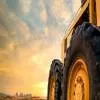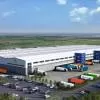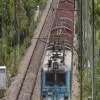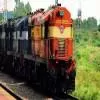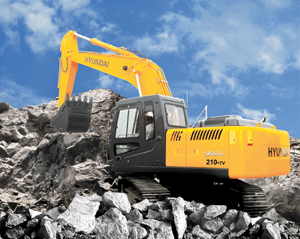
Rock and roll
Policy paralysis has slowed demand for all sorts of earthmoving equipment. Sales were sluggish last year. But recent attention to economic revival might help turn the tide this year.
Revival mode
After the setback suffered in 2012, Gurman Reen, Sales Manager, Caterpillar India Pvt Ltd, expects the industry to regain some of its lost momentum and demonstrate 5-10 per cent growth this year. "Key road, mining and port projects continue to be on hold and projects that kick off will be on constrained budgets," he says. "But the long-term growth story continues to be positive and encouraging."
According to Dheeraj Panda, Head-Marketing & Sales, Hyundai Construction Equipment India Pvt Ltd, "Total sales of excavators in 2013 are likely to mirror last year's figures, at around 13,700 to 14,000 units. Sales will slow down in the first half of the year but pick up during the latter half on the back of expansion in the real-estate sector."
"A lot depends on government decisions," adds Panda. "A decision in favour of opening mining blocks could boost the market, as would initiatives to promote infrastructure construction, provide credit on better terms, encourage FDI inflows in the construction sector, and pro-manufacturing sector policies."
"Demand for construction equipment has slowed down considerably," says Prabhat Kumar Tiwari, Business Head, Sany Heavy Industry India Pvt Ltd. "Demand for motor graders has especially slowed as a lot of big projects are held up by lack of Central Government decision-making. Thankfully, small infrastructure development activities are continuing and the retail market is buoyant. But we are hopeful that infrastructure development revives in the near future, which will boost big-ticket orders for metro, monorail system, rural road, four-lane expansion, expressway and other projects."
Growth factors
In this wavering market, customer preferences are veering towards highly productive models. "Companies facing time and financial pressures are preferring models delivering lowest ownership and operating costs over the product lifecycle, as well as faster production with the highest uptime, which would help them meet their project deadlines," observes Reen.
According to BV Raisinghani, President (Purchase), Jaiprakash Associates Ltd, "We carefully evaluate the hydraulic and lubrication systems as these add to machine reliability. We prefer Komatsu or Caterpillar brands for their superior performance, after-sales network and lower cost of ownership. Overall, the Indian market offers sufficient options of excavators, dozers, dumpers and graders. The choice in the most popular 20-tonne category is wider, as machi¡nes with less than 40-tonne capacity are being manufactured in India."
Manufacturers are responding to the emerging needs and priorities of customers. Caterpillar, for instance, offers the Cat 320D hydraulic excavator, the 120K2 motor grader, the D6R dozer and the 950H wheel loader, all of which have been designed and built to exceed the Indian customer's expectations. According to Reen, "Popular features include the remote machine health monitoring system, which helps customers to maximise machine utilisation. Features improving fuel efficiency, such as the economy mode on the Cat 320D hydraulic excavator and ACERT engine technology, are huge successes. Also, customers look for machine workhorses that can help them improve bottomlines. For instance, the Cat 950H wheel loader works 20 hours a day at major ports, which is made possible through world-class power train and hydraulics technology."
Hyundai is seeing greater takers for fuel-efficient excavators, especially for versatile 20 tonners that can be applied for varied applications such as soil, quarry, trenches, etc. "In this segment, Hyundai is making inroads through its range of customised products," says Panda. The R210-7, R210-7v, R215LC-7, R220LC-7, R220LC-9 and R220LC-7Rock are each tailored to meet the diverse specification of our clients. Demand for 8-14 tonne excavators is growing from contractors executing small-scale projects within municipal limits as well as in rural areas. Hyundai has a range of lower cost fit-for-purpose machines to meet this need that help customers to add value to their bottomline."
New models
A significant positive market development is the continuous focus on innovation, with the objective of giving Indian construction companies better models.
Hyundai unveiled the R210-7v, a 21-tonne versatile excavator, at Bauma 2013. Its advantages include the 6R1080T KOEL engine, mechatronics for optimised fuel consumption and productivity, low operating costs, stability in the toughest and most rugged working terrains, fuel savings of up to 6 per cent, and 12 per cent more productivity than comparable models. Hyundai has also added its 9 series high-end excavators in 14 tonne and 22 tonne, all of which are being presented as value for money and eco-friendly.
Innovations are ongoing at Caterpillar too. It launched the 120K2 motor grader in 2011 meeting BSIII emissions and offering excellent productivity, owning and operating costs and resale value. Another feature that Reen expects to become dominant in future is machine control and guidance through Cat Accugrade. Progress on this is brisk.
Sany is concentrating on its excavator business ¡- products that stand out for being both corporate and retail buys. "We are preparing for greater retail sales through close scrutiny of dealers," reveals Tiwar. "We are looking for dealers with an impeccable track record, with sufficient manpower and the right attitude towards product promotion and fast diagnosis and resolution of complaints."
Tiwari acknowledges that excavators are highly price-sensitive products that need strong technology back-up and support services. Yet he is confident about the performance of Sany excavators in all kinds of working conditions, their reliability, higher productivity, greater fuel efficiency, and wear-proof and reinforced structure. "We call them Next Generation excavators," he adds. Sany has plans to introduce port equipment, backhoes and dumpers when the market matures and demand revives.
Evidently, the pipeline will start to move when things start looking up.
CASE STUDY 1: Evaluating average output and lifecycle
Product: Cat« 320D excavators
Manufacturer: Caterpillar
Owner: ABC Associates, Satna, Madhya Pradesh
Purpose: ABC Associates are in the business of constructing canals, roads, buildings and bridges spread out over Madhya Pradesh. Currently, the company is executing the Rs 131-crore project of main canal construction at Nagod in Satna. The left bank canal of the Bargi diversion project covers a total length of 22 km.
Experience: "I decided that the Cat 320D would be a good buy for canal digging," says Subodh Singh Parihar, Owner, ABC Associates. "I have since purchased several Cat machines owing to their superior output and lifecycle. In India, average output is the most important criterion for judging machine performance. The Cat 320D machine features new technology. Dealer service is readily available; service engineers attend to complaints regarding machine performance within three hours. Owing to unforeseen expenses that suddenly came up, the dealer has made allowances and has even been providing parts without payment for the past six months, thereby helping us complete the project on time. What's more, the more the machine uptime, the higher the productivity, which means timely completion of projects. The Cat 320D is a good return on investment. Although fuel efficiency is average, non-fuel operating costs are low, making the machine economical in the long run. On-site maintenance training and operator training provided by GMMCO have proved to be very helpful."
CASE STUDY 2 : Prioritising value for money equipment
Product: Hyundai Excavator models R80-7, R110-7, R210LC-7 LR
Manufacturer: Hyundai Construction Equipment India Pvt Ltd
Owner: Regent Commercial Services, Kolkata
Purpose: Part of a fleet of 18 Hyundai machines rented out to construction companies Experience: "Hyundai machines deliver excellent value for money," says Asif Ali Khan, Owner, Regent Commercial Services. "They are rightly priced vis-a-vis comparable models with no compromise on functionality or services. Also, Hyundai has entered into tie-ups with financiers who offer buyer-friendly financing terms, which is a big incentive. After-sales services are prompt and readily available, another plus point."
Conserving momentum through high performing cylinders
Users evaluate the specifications of construction equipment prior to buying with the aim to maximise productivity. Efficiency of hydraulic cylinders in earthmoving (and other) equipment is a critical factor in establishing ROI. Unless they are highly efficient, desired output and timing plans will be affected. R Vasudevan, SVP and Global Sales Head, Wipro Infrastructure Engineering, elaborates upon the key innovations and smart features that mark Wipro's high-efficiency cylinders and that can be evaluated to predict equipment performance levels:
- Power-to-weight ratio: High-powered machines weighing less perform better. Some ways in which this delicate balance can be achieved are by reducing bore size and increasing operating pressures, using high-strength alloy and micro alloy steels, increasing operating pressures from 190 bar to 350 bar, using hollow rods for less weight, incorporating specially engineered high-temperature sealing system permitting longer up-time of machine, and optimising the shapes of parts to reduce the material consumed, such as cap end forgings and glands.
- Operating speed: Key methods to reduce cycle time and thereby increase efficiency include incorporation of special sealing to increase oil flow so that rod speed correspondingly rises, reduction of bore sizes, increase in rod speed capabilities from 0.15 m/s to 0.5 m/s, achieving super finer surface finish to reduce initial drag pressures (inertia losses), protection of equipment from shocks at higher speeds through effective advanced cushioning features, and enhancement of operator comfort.
- Technology and validation: Advanced hardware and software have helped Wipro enhance the quality and reliability of cylinder performance. A few of these tools are 3D modelling by latest versions of software (ProE), Product Data Management System (Windchill), simulation using software and in real time, integration with customer CAD systems, predicting the lifecycle by FEM analysis using Ansys, evaluating product lifecycle by accelerated life tests using real-time physical samples, and utilising sophisticated instrumentation.
- Contamination control: Contamination is a silent killer of hydraulic systems. It triggers system malfunction that can develop into sudden catastrophic failures. Wipro Infra has developed end-to-end process sequences to eliminate harmful contamination starting from component cleanliness to hydraulic oil cleanliness. Parts are cleaned with multi-stage combo cleaning, which includes ultrasonic cleaning. This process offers enhanced and efficient cleaning of parts with reference to prevailing standards.
Indicative costs
- While most equipment have a working life of seven to 10 years, below are suggestive cost for a few.
- Excavators, the most popular 20 tonne series, cost between Rs 45 lakh and Rs 60 lakh.
- Dozer prices vary depending on the horse power - series ranging from 165 hp to 185 hp - typically cost between Rs 80 lakh and Rs 1.3 crore.
- Dumpers of 16 cu m dump capacity with 10 wheels range between Rs 25 and Rs 30 lakh.
- Graders of around 140 hp can cost between Rs 40 lakh and Rs 80 lakh.
To share your views on India's Earthmoving Equipment market, write in at feedback@ASAPPmedia.com
An overview of the fortunes of earthmoving equipment shows how much the industry is dependent on growth-oriented government policies, writes CHARU BAHRI. Policy paralysis has slowed demand for all sorts of earthmoving equipment. Sales were sluggish last year. But recent attention to economic revival might help turn the tide this year. Revival mode After the setback suffered in 2012, Gurman Reen, Sales Manager, Caterpillar India Pvt Ltd, expects the industry to regain some of its lost momentum and demonstrate 5-10 per cent growth this year. "Key road, mining and port projects continue to be on hold and projects that kick off will be on constrained budgets," he says. "But the long-term growth story continues to be positive and encouraging." According to Dheeraj Panda, Head-Marketing & Sales, Hyundai Construction Equipment India Pvt Ltd, "Total sales of excavators in 2013 are likely to mirror last year's figures, at around 13,700 to 14,000 units. Sales will slow down in the first half of the year but pick up during the latter half on the back of expansion in the real-estate sector." "A lot depends on government decisions," adds Panda. "A decision in favour of opening mining blocks could boost the market, as would initiatives to promote infrastructure construction, provide credit on better terms, encourage FDI inflows in the construction sector, and pro-manufacturing sector policies." "Demand for construction equipment has slowed down considerably," says Prabhat Kumar Tiwari, Business Head, Sany Heavy Industry India Pvt Ltd. "Demand for motor graders has especially slowed as a lot of big projects are held up by lack of Central Government decision-making. Thankfully, small infrastructure development activities are continuing and the retail market is buoyant. But we are hopeful that infrastructure development revives in the near future, which will boost big-ticket orders for metro, monorail system, rural road, four-lane expansion, expressway and other projects." Growth factors In this wavering market, customer preferences are veering towards highly productive models. "Companies facing time and financial pressures are preferring models delivering lowest ownership and operating costs over the product lifecycle, as well as faster production with the highest uptime, which would help them meet their project deadlines," observes Reen. According to BV Raisinghani, President (Purchase), Jaiprakash Associates Ltd, "We carefully evaluate the hydraulic and lubrication systems as these add to machine reliability. We prefer Komatsu or Caterpillar brands for their superior performance, after-sales network and lower cost of ownership. Overall, the Indian market offers sufficient options of excavators, dozers, dumpers and graders. The choice in the most popular 20-tonne category is wider, as machi¡nes with less than 40-tonne capacity are being manufactured in India." Manufacturers are responding to the emerging needs and priorities of customers. Caterpillar, for instance, offers the Cat 320D hydraulic excavator, the 120K2 motor grader, the D6R dozer and the 950H wheel loader, all of which have been designed and built to exceed the Indian customer's expectations. According to Reen, "Popular features include the remote machine health monitoring system, which helps customers to maximise machine utilisation. Features improving fuel efficiency, such as the economy mode on the Cat 320D hydraulic excavator and ACERT engine technology, are huge successes. Also, customers look for machine workhorses that can help them improve bottomlines. For instance, the Cat 950H wheel loader works 20 hours a day at major ports, which is made possible through world-class power train and hydraulics technology." Hyundai is seeing greater takers for fuel-efficient excavators, especially for versatile 20 tonners that can be applied for varied applications such as soil, quarry, trenches, etc. "In this segment, Hyundai is making inroads through its range of customised products," says Panda. The R210-7, R210-7v, R215LC-7, R220LC-7, R220LC-9 and R220LC-7Rock are each tailored to meet the diverse specification of our clients. Demand for 8-14 tonne excavators is growing from contractors executing small-scale projects within municipal limits as well as in rural areas. Hyundai has a range of lower cost fit-for-purpose machines to meet this need that help customers to add value to their bottomline." New models A significant positive market development is the continuous focus on innovation, with the objective of giving Indian construction companies better models. Hyundai unveiled the R210-7v, a 21-tonne versatile excavator, at Bauma 2013. Its advantages include the 6R1080T KOEL engine, mechatronics for optimised fuel consumption and productivity, low operating costs, stability in the toughest and most rugged working terrains, fuel savings of up to 6 per cent, and 12 per cent more productivity than comparable models. Hyundai has also added its 9 series high-end excavators in 14 tonne and 22 tonne, all of which are being presented as value for money and eco-friendly. Innovations are ongoing at Caterpillar too. It launched the 120K2 motor grader in 2011 meeting BSIII emissions and offering excellent productivity, owning and operating costs and resale value. Another feature that Reen expects to become dominant in future is machine control and guidance through Cat Accugrade. Progress on this is brisk. Sany is concentrating on its excavator business ¡- products that stand out for being both corporate and retail buys. "We are preparing for greater retail sales through close scrutiny of dealers," reveals Tiwar. "We are looking for dealers with an impeccable track record, with sufficient manpower and the right attitude towards product promotion and fast diagnosis and resolution of complaints." Tiwari acknowledges that excavators are highly price-sensitive products that need strong technology back-up and support services. Yet he is confident about the performance of Sany excavators in all kinds of working conditions, their reliability, higher productivity, greater fuel efficiency, and wear-proof and reinforced structure. "We call them Next Generation excavators," he adds. Sany has plans to introduce port equipment, backhoes and dumpers when the market matures and demand revives. Evidently, the pipeline will start to move when things start looking up. CASE STUDY 1: Evaluating average output and lifecycle Product: Cat« 320D excavators Manufacturer: Caterpillar Owner: ABC Associates, Satna, Madhya Pradesh Purpose: ABC Associates are in the business of constructing canals, roads, buildings and bridges spread out over Madhya Pradesh. Currently, the company is executing the Rs 131-crore project of main canal construction at Nagod in Satna. The left bank canal of the Bargi diversion project covers a total length of 22 km. Experience: "I decided that the Cat 320D would be a good buy for canal digging," says Subodh Singh Parihar, Owner, ABC Associates. "I have since purchased several Cat machines owing to their superior output and lifecycle. In India, average output is the most important criterion for judging machine performance. The Cat 320D machine features new technology. Dealer service is readily available; service engineers attend to complaints regarding machine performance within three hours. Owing to unforeseen expenses that suddenly came up, the dealer has made allowances and has even been providing parts without payment for the past six months, thereby helping us complete the project on time. What's more, the more the machine uptime, the higher the productivity, which means timely completion of projects. The Cat 320D is a good return on investment. Although fuel efficiency is average, non-fuel operating costs are low, making the machine economical in the long run. On-site maintenance training and operator training provided by GMMCO have proved to be very helpful." CASE STUDY 2 : Prioritising value for money equipment Product: Hyundai Excavator models R80-7, R110-7, R210LC-7 LR Manufacturer: Hyundai Construction Equipment India Pvt Ltd Owner: Regent Commercial Services, Kolkata Purpose: Part of a fleet of 18 Hyundai machines rented out to construction companies Experience: "Hyundai machines deliver excellent value for money," says Asif Ali Khan, Owner, Regent Commercial Services. "They are rightly priced vis-a-vis comparable models with no compromise on functionality or services. Also, Hyundai has entered into tie-ups with financiers who offer buyer-friendly financing terms, which is a big incentive. After-sales services are prompt and readily available, another plus point." Conserving momentum through high performing cylinders Users evaluate the specifications of construction equipment prior to buying with the aim to maximise productivity. Efficiency of hydraulic cylinders in earthmoving (and other) equipment is a critical factor in establishing ROI. Unless they are highly efficient, desired output and timing plans will be affected. R Vasudevan, SVP and Global Sales Head, Wipro Infrastructure Engineering, elaborates upon the key innovations and smart features that mark Wipro's high-efficiency cylinders and that can be evaluated to predict equipment performance levels: Power-to-weight ratio: High-powered machines weighing less perform better. Some ways in which this delicate balance can be achieved are by reducing bore size and increasing operating pressures, using high-strength alloy and micro alloy steels, increasing operating pressures from 190 bar to 350 bar, using hollow rods for less weight, incorporating specially engineered high-temperature sealing system permitting longer up-time of machine, and optimising the shapes of parts to reduce the material consumed, such as cap end forgings and glands. Operating speed: Key methods to reduce cycle time and thereby increase efficiency include incorporation of special sealing to increase oil flow so that rod speed correspondingly rises, reduction of bore sizes, increase in rod speed capabilities from 0.15 m/s to 0.5 m/s, achieving super finer surface finish to reduce initial drag pressures (inertia losses), protection of equipment from shocks at higher speeds through effective advanced cushioning features, and enhancement of operator comfort. Technology and validation: Advanced hardware and software have helped Wipro enhance the quality and reliability of cylinder performance. A few of these tools are 3D modelling by latest versions of software (ProE), Product Data Management System (Windchill), simulation using software and in real time, integration with customer CAD systems, predicting the lifecycle by FEM analysis using Ansys, evaluating product lifecycle by accelerated life tests using real-time physical samples, and utilising sophisticated instrumentation. Contamination control: Contamination is a silent killer of hydraulic systems. It triggers system malfunction that can develop into sudden catastrophic failures. Wipro Infra has developed end-to-end process sequences to eliminate harmful contamination starting from component cleanliness to hydraulic oil cleanliness. Parts are cleaned with multi-stage combo cleaning, which includes ultrasonic cleaning. This process offers enhanced and efficient cleaning of parts with reference to prevailing standards. Indicative costs While most equipment have a working life of seven to 10 years, below are suggestive cost for a few. Excavators, the most popular 20 tonne series, cost between Rs 45 lakh and Rs 60 lakh. Dozer prices vary depending on the horse power - series ranging from 165 hp to 185 hp - typically cost between Rs 80 lakh and Rs 1.3 crore. Dumpers of 16 cu m dump capacity with 10 wheels range between Rs 25 and Rs 30 lakh. Graders of around 140 hp can cost between Rs 40 lakh and Rs 80 lakh. To share your views on India's Earthmoving Equipment market, write in at feedback@ASAPPmedia.com





